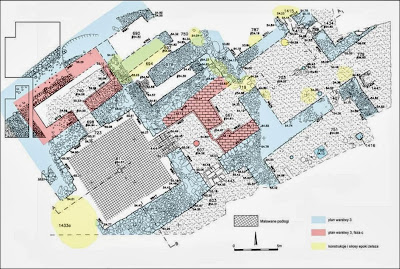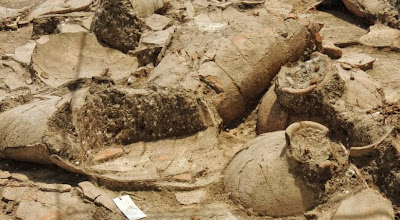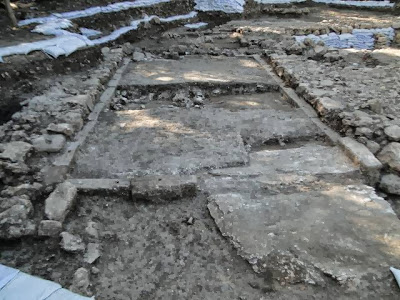
Canaanite Tel Kabri: big palace or big oikos?
Five kilometers from the Mediterranean coast, the Canaanite palace at Tel Kabri is a sprawling Middle Bronze Age edifice.
 |
| The western wing of the sprawling, 6,000-square meter Canaanite palace at Tel Kabri [Credit: Skyview Photography] |
We don't know what the site was called at the time, in part because its inhabitants seem to have built and run the enormous Middle Bronze Age palace continuously for over 250 years – from ca. 1850 BCE to the 1600s BCE – without writing anything down.
Nothing at all. Not a single seal, no inscriptions or text have yet been found in the 6,000-square meter edifice, with its multiple of banquet rooms and halls.
Yet this may be typical of Middle Bronze Age Canaanite society, say Assaf Yasur-Landau of the University of Haifa and Eric H. Cline of George Washington University, directors of the excavation.
Who were the Canaanites?
There is little evidence available to enlighten archaeologists as to who exactly the Canaanites were, and what system of rulership they had. There have been no significant findings of alphabetic writing from the region during the Middle Bronze Age. The few cuneiform tablets that were found mostly hail from Tel Hazor, a site associated with Syrian culture.
 |
| The Middle Bronze Age Palace in Area D-West at Tel Kabri [Credit: DigKabri 2009] |
The fragments and scraps found throughout the Land of Israel that predate the Iron Age do not add up to a literate society, especially given that this land was bounded by Egypt and Mesopotamia. Both had very advanced civilizations by the Middle Bronze Age, and each had highly advanced writing systems. In fact, the Mesopotamian cuneiform system was used by everyone in the region for administrative purposes and international communication.
“The operating system of the Ancient Near East was cuneiform. You could call it Cuneiform OS,” says Assaf Yasur-Landau, one of two directors of Tel Kabri and chair of the Maritime Civilizations Department at the University of Haifa. “This system, which lasted for more than 3,500 years, came pre-packaged with a world view, and an orderly patterned Mesopotamian one at that. This world view centered around a king who rules by divine right, as can be seen in much of the art of the ancient near east. This ‘software’ is used by almost all of the lands of the region - except for the Levant.”
But did that world-view apply to the Canaanites? Apparently not: according to Yasur-Landau, new archaeological evidence indicates that they stood out from the Near Eastern region's peoples by developing a very different form of rulership.
Mysteriously sparse palaces
Even the palaces of Middle Bronze Age Canaan – 4,000 /3,500 years ago – were different from those of their neighbors.
 |
| Storage jars, possibly for wine, found in 2013 at Tel Kabri - but just enough to sustain a large household, not a redistributive economy [Credit: Eric Cline] |
A Near Eastern palace was expected to be a residence for the royal household, a seat for government and a center for economic enterprise, with archives, storerooms, living quarters and more. All this was needed because in the Near East, the palace economy was a center of redistribution.
This redistribution was controlled with the help of cuneiform writing in every part of the Ancient Near East – Mesopotamia, Syria and Anatolia – except for in one place: the Land of Israel, or as it was known then, Canaan.
“How is it possible to have palaces in the Levant, like in places such as Megiddo, Kabri, Aphek, Lachish, and Tel el-Ajjul, with no large - scale storage, no palatial workshops to manufacture goods, and no archives?” questions Yasur-Landau. “How is it possible to have redistribution if none of these elements exist?”
Perhaps there was nothing much to redistribute, as indicated by ancient Egyptian Middle Kingdom instructions to King Merikare, which portrayed the Levant as a place plagued by subsistence difficulties, endemic war, and a lack of rulership.
But there could be another explanation. Over 120 years of excavations have proven that the Levantine Middle Bronze Age palaces originated and thrived before the arrival of cuneiform as the administrative writing form of the land.
 |
| The Orthostat Building [Credit: Dig Tel Kanri 2013] |
Thus culture developed in the Levant the opposite from Mesopotamian and Egyptian systems. In the Levant, apparently, first came palaces, then urbanization, and, only much later, writing.
Even then, writing seems to have rarely been used for administrative purposes. So, by the time cuneiform reached Canaan, it may have been irrelevant to the development of Canaanite society.
Not only didn't the Canaanites use the regional norm, the cuneiform operating system: they left behind no images of rulership. The only information that we have concerning Canaanite rulers comes from the much later Amarna letters, dating from the mid 14th century B.C.E., and even there the rulers did not style themselves as kings - except the King of Hazor, who is affiliated with Syrian culture, as Yasur-Landau points out..
Yasur-Landau and his excavating partner Eric Cline, chair of the Department of Classical and Near Eastern Languages and Civilizations, call this conundrum “the problem of the missing ruler.” Cline notes that the same problem exists on Minoan Crete, where there is still no concrete evidence for who was in charge of the palace at Knossos, for instance.
The Canaanites did it backwards
Evidence from multiple disciplines, including zooarchaeology, and household archaeology, found that throughout 250-year life span, Kabri grew from a village to a small town; as it grew in size, it fortifications were added. People were flocking there. Interestingly enough, at Kabri, the palace came first, then the rampart was added. So the stronger the ruler became, his influence became more pronounced in the site and in the kingdom.
| University of Haifa excavations, 2011 [Credit: Hanay/WikiCommons] |
The site, which kept expanding and evolving until its very end, began as a fortress, and ended as a palace with multiple halls. Very thick accumulations on floor surfaces are clear, showing the site was used continually: older structures were simply absorbed into the new.
In that it's rather like the Tower of London, says Yasur-Landau: The larger it became, the more specialized the architecture.
Deck the walls with Aegean frescoes
“As the palace became more specialized, the more sophisticated the architecture became,” says Yasur-Landau. “Somewhere around the 17th century BCE, someone made a clear choice to decorate it with Aegean style frescoes (the parallels of which can only be seen at Tell el-Dab’a in Egypt), only to have all that discarded in a later phase.”
 |
| Plaster fragments found at the dig site [Credit: Nurith Goshen] |
Though the palace has many halls and a temple-like room with a recessed niche (but no cultic findings), no residential quarters were identified. Most likely they were on the top floor, which collapsed.
Another enlightening find from the 2013 season excavations was a storage complex with over 40 large storage jars, currently being tested for residue analysis. The stash of what appears to be wine jars may seem impressive, but it pales in comparison to store rooms found in Knossos and other Minoan palaces, which could have 250 pythoi or more. "This shows that this is not an example of a redistributive economy but rather evidence of just enough wine to satisfy the yearly needs of the palace elite and its dependents,” explains Yasur-Landau.
Pattern of animal consumption also speak volumes: like the commoners, the palace residents ate mostly sheep and goats, mixing it up with frogs and crab. No pork. This is in sharp contrast to the rest of the ancient Near East. Also, elsewhere palace residents made sure to let everyone know about their prowess, as shown in hunting scenes. No such scenes were found at Kabri, nor was there evidence of game consumed, with the exception of giant auroch.
It seems the Canaanite palatial diet was quite plain. The palace sported Minoan frescoes - the only ones of its type found in this region - and drafted stones for pavement, and an orthostat structure, but little other pomp.
“These people could bring artisans from Crete, surely they could have also commissioned one statue!” exclaims Yasur-Landau, meaning that it was an obvious choice for these people to behave the way they did.
Was this a palace - or just a really big oikos?
Was Kabri really a palace, or just a very big house? Did the Canaanites have a redistributive economy or an oikos economy – the palace not as the center of the state, but as the center of an estate?
 |
| Suggested reconstruction and placement of Fragment 2119–7 from area D-West, as part of a hilltop within the landscape depicted in a miniature composition [Credit: AJA] |
Several things point to Kabri really being an oikos - a large estate.
Yasur-Landau sees Kabri as the alpha household in town, as it were. "Through long-lasting contact with other families it managed to accumulate influence, debts, promises, property and land,” he postulates . “How was it organized? If it was organized like a large household it basically needed little or no taxation. Some goods must have gone to the palace from other people in the area but most likely it was through a system of obligation from other large households."
Based on the evidence, Yasur-Landau hypothesizes that the palace contained no more than several dozen inhabitants, living lavishly in a vast space able to host a wide range of activities in which many people could take part. These could range “from 500 people eating an aurochs in the courtyard to maybe a few dozen drinking wine in the central hall of the palace to a few elites drinking wine and eating goat in the orthostat structure,” says Yasur-Landau.
At the moment, it seems that Kabri was home to a homemade and slowly evolving palace which left behind no sign of administration; although Tel Hazor and its vast libraries and other advancements were just next door, none of it reached Kabri. It was a system that managed to consolidate itself before cuneiform reached this part of Canaan.
This system lasted without interruption for over 250 years. Since there is no evidence of violent destruction throughout all of this time, it seems to point to the growth of a single family or dynasty.
The bottom line is that the excavations at Kabri seem to indicate that the Canaanites controlled or ruled through a system of obligation. A relatively small group of people seems to have maintained a palace with no taxation nor administration, without large-scale storage, without a cuneiform school, and without the epic of Gilgamesh.
"It may well be that the ancient Canaanites are more a part of the Mediterranean world than the ancient Near East,” Yasur-Landau concludes.
Author: Julia Fridman | Source: Haaretz [21-10-2013]
Elérhetőség
www.gazdtort.com
PTE BTK TTI Ókortörténeti TanszékH-7624 Pécs, Rókus u. 2.
+36-72-503600-23522